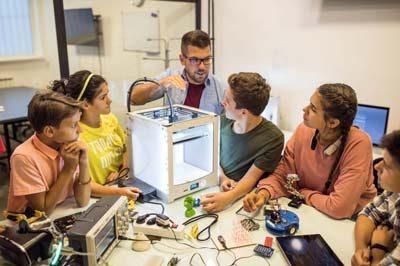
Since the beginning of the last decade, 3D printing has become quite a popular trend among creative minds and professionals alike.
That is when the first commercially available 3D printer made its debut in the market. We have come a long way since then and this technology has also evolved every year.
So in order to join this wonderful journey and see your visions materialize in front of your very eyes, you need to know the basic terms of this process! That is why we have brought you here the most common 3D printing terms along with brief explanations.
3D Printing Terms That You Should Know
1. Filament
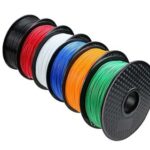
A. What Does It Mean
Filament refers to the main material which your 3D printer takes in and then converts into your desired shape or structure. This is essentially the thread for your craft of 3D printing.
The most common filaments are thermoplastic like ABS, PEGT and PLA. They usually come in spools with wires of 1.75mm or 3mm width.
Speaking of spools, stop by our article on What to Do With Old Filament Spools! We share fun ideas to repurpose your spools.
B. Applications
You will need to put the filament in your 3D printer which will then come out through its nozzle or extruder to form layers. The accumulation of all these calculated layers will then form the shape or structure you programmed.
2. Slicing
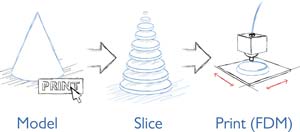
A. What Does It Mean
Slicing in 3D printing refers to the process of dividing a shape or image into multiple layers. This is how the printing machine converts your programmed 3D model into an instruction file it can understand.
Slicing is basically the translation of a 3D object model’s language into the 3D printer’s language.
B. Applications
After slicing the original image, your 3D printer can finally begin printing the shape or structure by laying down each slice over each other.
The software which carries out this function of slicing is called a slicer. Without this function, your printer could not understand what the 3D model file is trying to convey.
3. Extruder
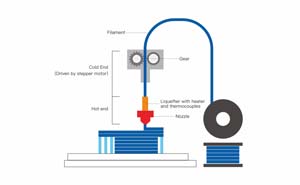
A. What Does It Mean
What is an extruder in 3D printing?
An extruder represents the whole set of parts that are responsible for feeding and ejecting the filaments on the print bed.
The components of an extruder usually include a motor, an idler and a filament drive gear. Extruders are typically available in three types named Direct, Bowden and Dual.
B. Applications
It has two parts called the hot end and the cold end. The former part melts filaments and ejects them in extremely thin layers through a nozzle.
Each thread of filament is pulled from the spool and fed into the printer through the cold end. So the extruder functions as an intermediary between the spool and the bed.
Read More: What is a Hot End On a 3D Printer? Learn what makes hot ends tick and the best options on the market!
4. Post-Processing
A. What Does It Mean
The post-processing phase of 3D printing glossary represents all the work you have to do after the main printing job is done.
It usually includes finishing and refining tasks like removing excess material, removing support structures, washing, sanding, polishing and painting.
B. Applications
Doing post-processing tasks is necessary to ensure excellent quality for the end product. Professionals and creative perfectionists do it in order to enhance the quality of their printed structures.
It can make the object more appealing by filling up uneven spaces, removing overhangs and donning new colors.
5. Layer Height
A. What Does It Mean
Objects are produced in 3D printing by laying down multiple layers according to the software instructions. The height or thickness of each extruded layer is called layer height.
Since ideally, these layers should not be visible to the naked eye, they are extremely short and measured in microns.
Read our related article, What Causes Layer Shift in 3D Printing? If your layers aren’t properly printing, here are some possible causes and solutions!
B. Applications
Layer height is crucial to any 3D printing job since it indirectly dictates the timeframe for the task. Smaller layer heights require more layers to be extruded which can increase the total time taken to finish the job.
Similarly, larger layer heights mean the task can be completed fast with fewer layers.
So, what is a good layer height for 3D printing? Which layer height is the strongest and produces the best results? We go over it all in this guide!
6. G-code
A. What Does It Mean
G-code is basically the language your 3D printing machine understands. Once your 3D file goes through a slicer, its program is converted into a g-code so that the printer can start its job.
The sliced file contains all the translated commands your printer will follow in order to produce the shape or structure you had specified.
B. Applications
This code is an important element of the 3D printing process since it breaks down the barrier between your 3D object model and the 3D printer.
Because of g-code, your machine doesn’t have to struggle with the software programming. It comes with specific instructions to move geometrically which is easier for the printer.
7. CAD

A. What Does It Mean
CAD is short for Computer-Aided Design – the most widely used software system in 3D printing. You can use it to design the 3D model on your computer.
After preparing the design following your requirements, CAD can save the electronic file in any format you want. Common choices, in this case, include STL, OBJ and 3MF.
B. Applications
Its extensive set of functionalities allow you to modify the tiniest details and analyze the required parameters. It ensures maximum efficiency and productivity for the professionals who need to complete an overwhelming number of 3D printing jobs in a day.
8. FFF/FDM
A. What Does It Mean
FFF (Fused Filament Fabrication or Filament Freeform Fabrication) and FDM (Fused Deposition Modeling) are very similar printing processes. They both use a continuous filament to build the programmed 3D structure by depositing multiple layers.
B. Applications
The subtle difference between these two processes lies basically in the target user groups. FFF is meant for hobbyists or enthusiasts who are not involved in 3D printing professionally, while FDM caters to industrialists who require engineering-grade premium quality prototypes.
9. STL
A. What Does It Mean
STL stands for Stereo Lithography which is a file format available in CAD software. This is the most common format used to design and save 3D designs.
Each of these files contains specific instructions regarding geometric movements using binary and ASCII codes. It does not specify other attributes like color and texture.
Read More: Lithographic Printing Advantages. We cover the advantages and disadvantages of Lithographic printing here!
B. Applications
It is one of the oldest file formats which has been here since 1987. So most brands and professionals who work with 3D printing rely on STL for rapid prototyping. For the same reason, a wide range of software systems is compatible with this format.
10. OBJ
A. What Does It Mean
This is another common file format used in 3D printing but much more evolved than STL. Along with the information about surface movements, these files can also store information regarding the color and texture of your desired 3D shape or structure.
B. Applications
The popular 3D designing software CAD supports OBJ files. They are usually open-source which helps the 3D printing teams to share the file with each other. It rose to popularity because of its ability to support instructions about appearance features.
11. Resolution
A. What Does It Mean
What does resolution mean in 3D printing?
As with most things, resolution refers to the size or area measurements of a product in 3D printing glossary. The difference is that here it is represented through the axes of XY and Z.
The first part is well-known since it deals with 2D aspects like length and width. For 3D you also need the third factor – height.
B. Applications
The significance of resolution is paramount in 3D printing since its value or specifications determine the size of your end product.
The XY dimension represents the thickness of each layer in your product while Z decides the layer height. This resolution is typically measured in millimeters or microns.
Read our related article, Gaps in First Layer 3D Print to see how to get the first layer right!
12. Overhang

A. What Does It Mean
Overhangs are the parts of a 3D printed structure that lean forward without the help of any support structure. The degree of this leaning can be anywhere from little to a lot.
However, it is recommended to not leave too much overhang on a structure since it can easily droop and ruin the entire design.
B. Applications
It is used to construct innovative or artistic structures where unconventional shapes occur.
Usually, 3D printers can easily deal with overhangs below 4 degrees. You can expect to extend it up to 45 degrees at most after which you will need support structures underneath.
13. Shell

A. What Does It Mean
Shell simply refers to the outer wall of a 3D printed structure. You can customize its thickness with the relevant settings available on your slicer software.
But for that, you need to first modify some other setting parameters like temperature, printing speed and layer height so that the intended structure prints properly.
B. Applications
You can use shells in post-processing to refine the finished product since many of its previous layers may need to be removed. As a result, the shells can add the lost thickness back to your printed structure. They are also used to make a product stronger.
14. SLA
A. What Does It Mean
SLA is the shortened form of Stereo Lithography – the first-ever technology of 3D printing. It follows an additive manufacturing principle by using photosensitive polymer resins instead of filaments.
Laser beams of ultraviolet rays are utilized for curing each layer of the resin. SLA was first introduced and patented in 1986.
B. Applications
This happens to be one of the most cost-effective 3D printing processes out there. It successfully delivers smooth finishing and high accuracy in the end product. UV lasers create each layer in SLA through the selective curing of resins.
15. SLS
A. What Does It Mean
SLS or Selective Laser Sintering is another technique of 3D printing that follows the additive manufacturing principles and uses laser to create the structure. However, the difference between SLS and SLA is that the former method uses powder as the printing material instead of resin.
B. Applications
This technology is mostly used for producing component parts in low volume and rapid prototyping. SLS guarantees better efficiency and makes building complex geometric shapes easier. It is one of the newer 3D printing technologies which can be commercialized on bigger scales pretty soon.
Read More: Difference Between SLA and SLS 3D Printing. Here’s all you need to know!
16. Glass Transition Temperature
A. What Does It Mean
Glass transition temperature or “Tg” represents the lowest temperature where the printing material can start warping.
After reaching this temperature, the polymer of your material begins becoming harder and brittle from its ductile consistency. Remember to check the Tg of each printing material before use.
B. Applications
Tg dictates the temperature at which your 3D printing substance will start melting slowly. It varies between materials, as well as brands depending on how the particular brand manufactured the component.
The usual range of glass transition temperatures is -5 to 15 degrees.
17. Infill
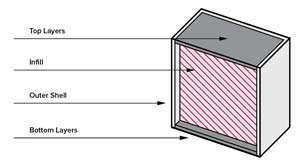
A. What Does It Mean
The term infill represents the repetitive structure present inside your printed structure. It usually stays hidden inside and does not become visible to the naked eyes unless you design a structure that highlights its patterns.
Usually, an infill density between 10% to 20% is enough to make your print stronger.
B. Applications
Infill plays an important role in maintaining a weight requirement by influencing its value through some extra fillings. Besides, it enables your printer to draw horizontal edges on empty space without the fear of falling apart.
As a result, the print gains more stability and strength which instills more confidence on your part.
18. Curing
A. What Does It Mean
Curing in 3D printing means hardening a liquid material like resin using ultraviolet rays. This is done by applying the UV light on the resin whose wavelength goes through several photochemical reactions. Typically, the value of these UV wavelengths ranges between 10 and 400 nanometers.
B. Applications
This step is used in the post-processing work of SLA printing. It can also dry the adhesives, coatings and similar wet components of the finished product. Depending on curing has helped to make the workflow more efficient by being an ideal substitute for two-part adhesives.
Read More: SLA vs PLA Strength and Applications. We compared SLA and PLA so you don’t have to!
Conclusion
Now that you know all the common 3D printing terms, you can finally read up on our extensive knowledge-base and guides regarding this evolving technology.
Hopefully, this glossary helped you to learn about the basic and most common terms used in 3D printing. Be a part of the exciting 3D printing world where you can create literally anything you want by only designing and implementing it properly!